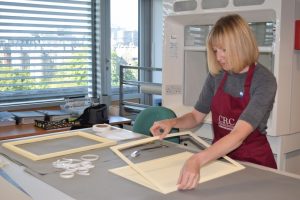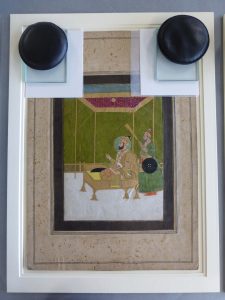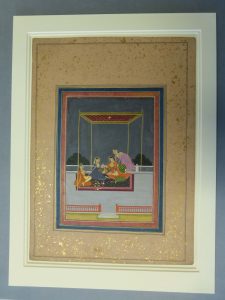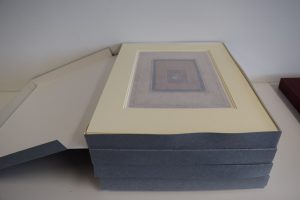Lisa Mitchell, conservation placement student from Northumbria University, describes her experience of working at the CRC in this week’s blog post…
Over the past two weeks I have had the pleasure of working with the conservation team at the CRC as part of my summer placement for my Master’s degree in conservation on works of art on paper.
Following an intense but fulfilling first year studying at Northumbria University, the summer has provided a very welcome respite from assignment writing and the opportunity to put some of my newly taught conservation skills into practice!
Working alongside Emily Hick, the Special Collections Conservator, I have been fortunate enough to assist her in the completion of the final stages of the conservation treatment of a collection of 32 portraits from India, which Emily has recently written about in her Passage to India blogs (part 1 and part 2 can be read by clicking on the highlighted text).
Before reaching their final destination, the portraits, known as Tasawir, had to be mounted in individual hinged frames and boxed so they would be ready for storage, public access and future display.
Work commenced with the creation of the display mounts; these were constructed from 4 ply buffered, acid-free mount board. The hinges were made by fixing two sheets of board (one cut mount and one solid board) together with strips of Tyvek, an inert spun-bonded (non-woven) polyethylene, adhered with EVA glue. A further mount with a larger aperture was then attached to the hinged frames to create a double window mount for each individual portrait. The additional mount serves to add depth to the overall frame and therefore greater protection for the fragile surface of the individual artworks. It also serves to enhance the aesthetic qualities of the portraits too; drawing the viewer’s eye to the intricate detail and exquisite colouring of each piece. Despite the variation in portrait sizes, all the mounts were cut to the same size; only the size of the window aperture was adjusted to accommodate this, thus allowing the artworks to be stored together with ease. The consistent measurements also enables standardised frames to be made for the artworks when used for future exhibition displays.

Creating the display mounts
Once the housing for the portraits was completed, we turned our attention back to the artworks themselves. In order for them to remain safe and secure within their frames they had to be float mounted onto the back board; this involved selecting an appropriate weight Japanese paper which was then cut into 1.5 x 3.0cm strips and adhered into place on the reverse of the artwork using wheat starch paste. However, before the Japanese paper could be attached to the object, the strips were folded to create a ‘v’ hinge; this enables the artwork to ‘float’ within its frame without any of the support mechanism being visible to the eye. These ‘v’ hinges were then pasted to each top edge of the object. Once in place, the portraits should hang securely (and squarely) within their frame!

Creating a ‘v’ hinge for attaching artworks to display mount
The use of Japanese paper in conservation is very common indeed; it has long fibres which are strong and lightweight, making it ideal for hinging, backing and repairing paper objects. Two Japanese papers were selected for the hinging of these artworks; 12gsm and 18gsm; these were chosen according to their compatibility with the artworks in terms of weight, transparency, colour and strength.

Painting in-situ with v-hinges pressing

Mounting completed!
Finally, once the portraits had been mounted within their new frames, we set about making boxes in which to store the conserved artworks. These were constructed using 650gsm box board; a buffered barrier board which is acid-free and has good folding characteristics.

Mounted artworks stored within new boxes
Now, beautifully housed, the Tasawir are finally ready for their temporary resting place, where they are available for seminar teaching and display…let’s hope this marks the beginning of their journey for the public to enjoy for many years to come.
This has been just one of the projects I have had the good fortune of working on during my placement at the Centre for Research Collections, which has also involved everything from cleaning oriental manuscripts, creating new housing for comic books to conducting a conservation survey on a collection of Scottish maps! I have learnt new skills and techniques which complement my studies; I have also met and worked with dedicated and talented staff members, willing to share their invaluable insights and knowledge, for which I am immensely grateful. The Tasawir may have completed one journey, but my learning journey continues…!
Lisa Mitchell
Student Placement
Northumbria University
